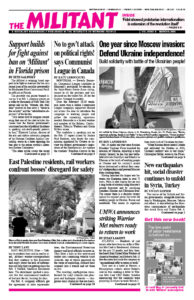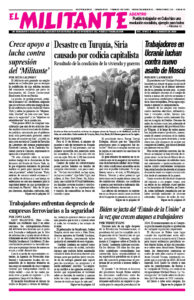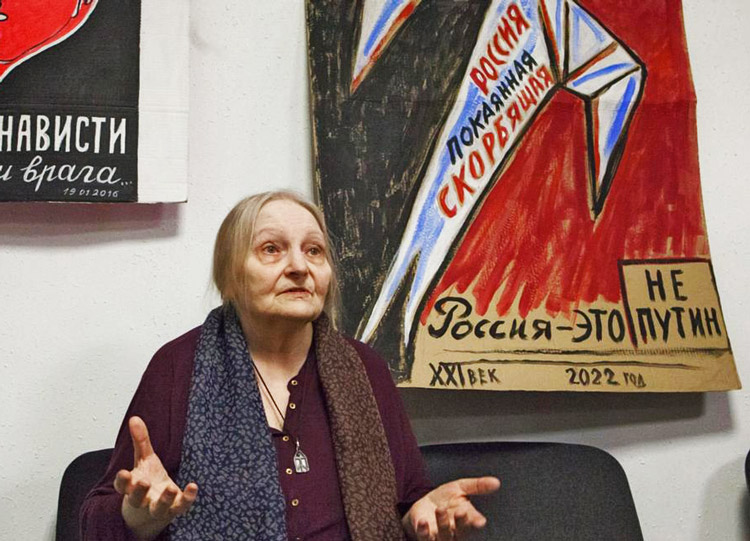Feb. 24 marks one year since Russian President Vladimir Putin launched his invasion of Ukraine, expecting a rapid victory. Instead, he has run into battlefield reversals from Kyiv and Kharkiv to Kherson at the hands of working people in Ukraine and the country’s armed forces determined to defend their country’s independence and prevent Moscow from crushing them.
Having launched the largest war between two European states in over 75 years, Putin is now hoping he can win a long battle of attrition using Moscow’s greater firepower and by sacrificing countless Russian and Ukrainian lives. The sooner there is a decisive victory against his regime’s army, the better for working people in Ukraine, Russia and worldwide. That means its expulsion from every inch of Ukrainian territory.
“When Russian forces seized Crimea and infiltrated the Donbas in 2014, Ukraine’s military was in bad shape,” Christopher Miller, wrote in the Financial Times. “Demoralized after years of neglect, it had just 5,000 combat-ready troops.”

But “thousands of Ukrainian volunteers filled the void,” Miller said.
“We will disappear as a nation if we do not fight,” Andriy Zotov, 49, a polar scientist who traveled from Antarctica to join the volunteers, told the Wall Street Journal. “We went to the front line not because we wanted to fight,” he said, but “because we had no choice.”
With a population less than one- third that of Russia, Ukrainians have volunteered from all walks of life — truck drivers, construction workers and farm hands, musicians, dancers and professionals. Their determination to defend their country’s existence has deepened since the invasion began, just as it was reinforced during the mass movement in 2014 that toppled the pro-Moscow thug regime of Viktor Yanukovych that ruled Ukraine. Millions of working people joined that struggle, transforming themselves as they faced down Yanukovych’s deadly attacks.
Women were barred from combat roles in the Ukrainian army until 2018. Now 50,000 serve, including in front line positions. The army doesn’t yet have enough women’s uniforms for all the volunteers.
Anastasia Kolesnyk enlisted the first day of the war, “because when a murderer and a thief comes to your house, you don’t just run away — you try to protect it. And everything was at stake.”
“I never held a rifle in my hands and never even saw one up close,” Yulia Bondarenko told the New York Times.The teacher volunteered for the Ukrainian infantry during the Kremlin’s failed drive to take Kyiv. Following the Maidan uprising, she said, she had begun to learn about the injustices perpetrated by Moscow against Ukrainians.
Initially fearful she didn’t have the abilities to fight, Bondarenko learned step by step on the job. “It was pleasant when the guys said, ‘It’s working out with you,’” she said. “And they said, ‘I would go into battle with you.’”
Bonderenko’s mother, Hanna, said she “was happy I didn’t have a son because I didn’t have to worry about him going off to war. I never imagined my daughter would sign up.”
After a series of setbacks its forces suffered, the Kremlin has recalibrated, throwing masses of its troops — workers and farmers in uniform — into assaults along Ukraine’s eastern front in the Donbas. Most are poorly trained and equipped conscripts. Many tens of thousands have been killed or injured, including over 30,000 Wagner mercenaries recruited from among former convicts.
During more than six months of attacks on Bakhmut, the Russian army and private Wagner fighters have only made creeping advances. Kyiv’s forces have so far held Bakhmut despite the fact that Moscow’s relentless shelling has reduced the city to rubble.
Putin’s war isn’t popular in Russia
The arrests of over 20,000 anti-war protesters last year quelled any sizable public protest in Russia for now. But silent “flower protests” to commemorate Ukrainians killed in Moscow’s airstrikes, solo placard-holding actions and other ways of making opposition known continue.
A Peaceful Art Protest in St. Petersburg exhibiting anti-war posters by artist Elena Osipova was closed down Feb. 1. It was hosted by Yabloko, a liberal bourgeois opposition party.
Osipova, 77, is renowned for standing with her posters against Moscow’s war in Ukraine and against the Putin regime. She is frequently arrested. Her first poster protest was held in 2002 during Moscow’s war in Chechnya. Because she is widely respected by friends, neighbors and others across Russia, cops prefer to take her home rather than risk provoking further outrage by detaining her.
“I am not scared of anything,” Osipova told Novaya Gazeta. “Why can’t I say or do something in my country in a peaceful manner, without weapons? I can do anything.”
In the years immediately after the Bolshevik-led 1917 Russian Revolution, the workers and farmers government granted oppressed nations within the former czarist empire the right to determine their own future. There was an explosion of political and cultural activity. This was bloodily suppressed in the course of a bureaucratic counterrevolution headed by Joseph Stalin.
At the end of the Cold War, after decades of crushing political opposition, the Stalinist police state regime came apart. Museums and theaters reemerged as centers of cultural freedom and places where Russians could learn some of the truth about the history of Stalin’s repression.
Putin has used his wartime clampdown on political rights to make new laws against keeping historical records from the Soviet era. The Kremlin shut down the Sakharov Center in Moscow as “undesirable” Feb. 15. It was named after the famous Soviet dissident, Andrei Sakharov.
Memorial, an organization that commemorates victims of Stalin’s gulags and exposes Putin’s attacks on political rights, was shut down in 2022.
“But you can’t ban people from thinking,” Yan Rachinsky, chairman of Memorial, told the New York Times. “What the authorities are doing today does not guarantee them any longevity.”


